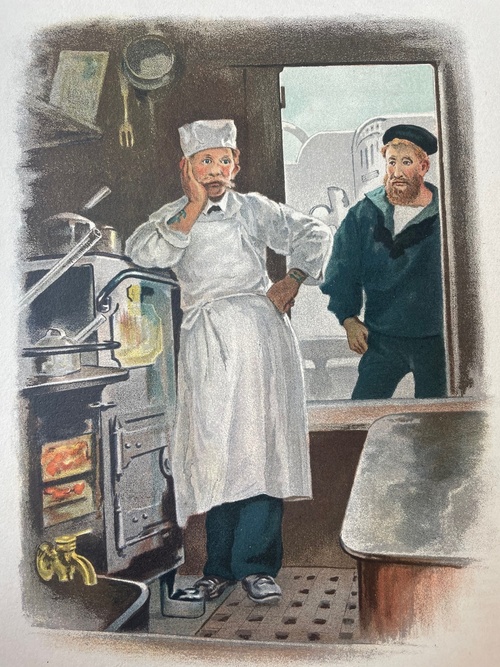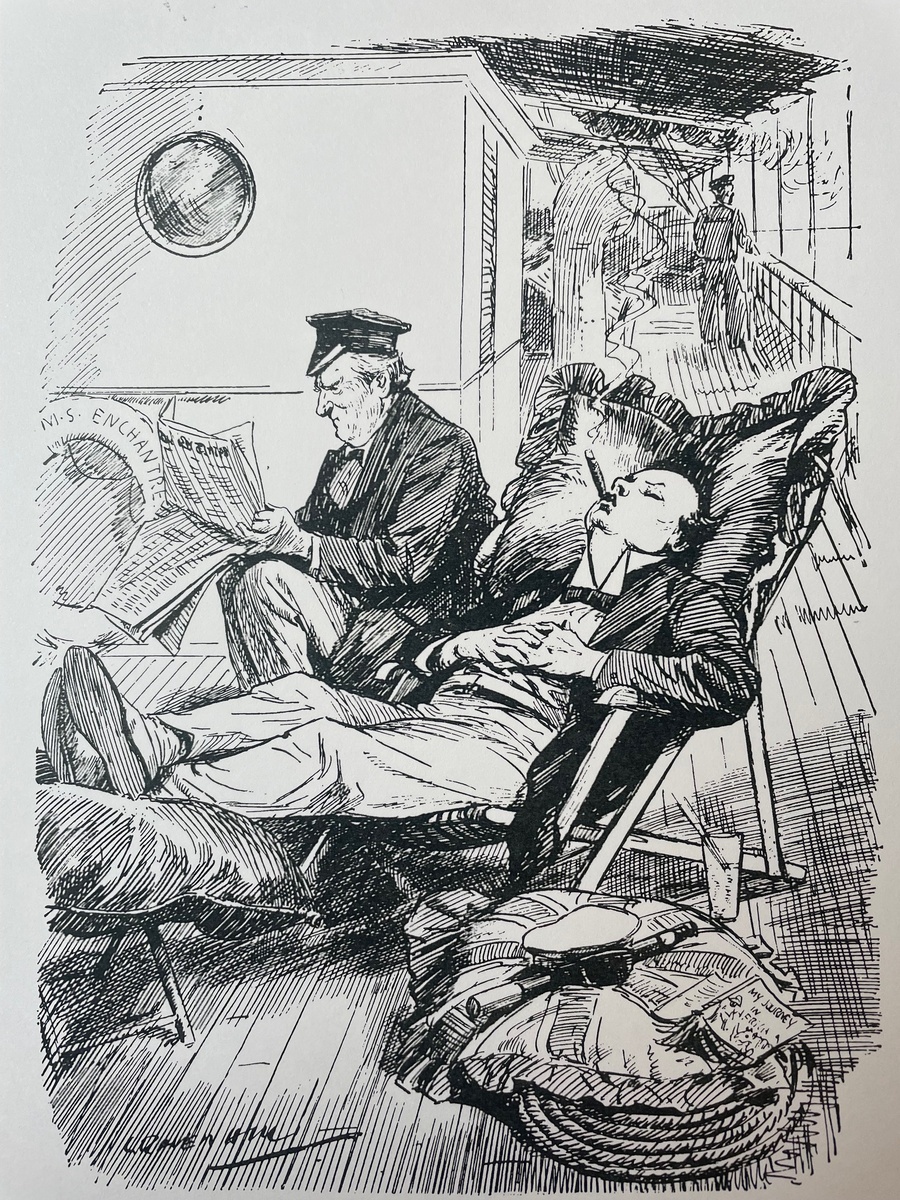Auction: 24003 - Orders, Decorations and Medals
Lot: 91
(x) Seven: Officer's Cook 1st Class W. H. Barrett, Royal Navy, a long-served seaman whose career spanned nearly four decades and saw him cook for Winston Churchill and latterly share in the Battle of the Falkland Islands
South Africa 1877-79, no clasp (W. H. Barrett. Asst. Baker H.M.S. "Tamar"); Egypt and Sudan 1882-89, dated reverse, 1 clasp, Suakin 1884 (W. H. Barrett. Asst. Cook, H.M.S. Tamar); British War and Victory Medals (98894 W. H. Barrett. O.C. 1, R.N.); Coronation 1902, bronze; Royal Navy L.S. & G.C., V.R., narrow suspension (W. H. Barrett. Wd. Rm. Cook, H.M.S. Malabar); Khedive’s Star 1882, good very fine and a most unusual combination of awards (7)
Ex-Oliver Stirling Lee Collection, December 2004.
William Henry Barrett was born at Poole, Dorset, on 12 October 1850 and was a baker by trade when he joined the Royal Navy in October 1876.
He served in a series of troopships which were the only ships at that time with baking facilities. The first was Tamar, in January 1878 she carried the 74th Highlanders from Singapore to Hong Kong. Tamar was to have a long association with Hong Kong; she became the receiving ship and depot there, gave her name to the shore base and was eventually scuttled there in 1941. In March and April 1879 she carried troops to South Africa for service in the various wars which broke out at that time; the most well-known was the Zulu War but there were also campaigns against the Galekas, the Basutos and other tribes (Medal without clasp). In August and September 1882 Tamar was present off the coast of Egypt during the operations against Arabi Pasha (Medal without clasp, Bronze Star). In June 1883, Tamar paid off and, the following month, Barrett joined the Orontes. In the Spring of 1884 she was deployed off the Red Sea coast in the operation against the dervishes of the Mahdi (clasp to Medal).
In September 1887 Barrett began a nine year tour of duty in Malabar. Since their construction was paid for by the Indian Government, the white-painted ships all had the 'Star of India' emblazoned upon their bows. In fact, the five ships were identical except for a distinguishing coloured stripe painted around the hull: Malabar (black), Serapis (green), Crocodile (yellow) Euphrates (blue) and Jumna (red). They remained in service until the 1890s and became familiar to generations of British soldiers and their families. Two of them were mentioned in Kipling's 'Barrack Room Ballads':
'The Malabar's in 'arbour with the Jumner at 'er tail,
An' the time-expired's waiting of 'is orders for to sail.'
Barrett remained in Malabar until she was withdrawn from service in April 1896, he earned his L.S. & G.C. Medal and was shore pensioned in December 1898.
In March 1899 he was re-employed as a Pensioner and served in Devastation, present at the Coronation Review for King Edward VII on 16 August 1902. The King directed that the bronze Coronation Medal should be presented to one seaman or marine on board each of the ships present at the review: criteria for award were (a) Below commissioned rank (b) the longest service and (c) of continuous 'Very Good' character.
Cooking for Churchill
After a draft to Vernon, the torpedo school at Portsmouth, in 1904 Barrett was posted to Enchantress, the Admiralty yacht, described as '...a miniature liner of some 2,000 tons, complete with its own boardroom and wine cellar.'
He was designated 'Officers' Cook 1st Class'. In July 1911 there was an order that he be retained in the service as a special case despite being over the age limit. On 31 October 1911 Winston Churchill was appointed First Lord of the Admiralty and, over the following three years, spent several months each year in the vessel. Churchill wrote of the Enchantress:
'The Admiralty yacht Enchantress was now to become largely my office, almost my home: and my work my sole occupation and amusement. In all, I spent eight months afloat in the three years before the war. I visited every dockyard, shipyard and naval establishment in the British Isles and in the Mediterranean and every important ship…Officers of every rank came on board to lunch or dine and discussion proceeded without ceasing on every aspect of naval war and administration.'
Presumably Barrett's culinary skills measured up to Churchill's exacting standards ('...My tastes are simple. I am easily satisfied with the best!') for he remained in the yacht until August 1914 when she was converted for use as a hospital ship.
Battle of Falkland Islands
At the beginning of October 1914 Barrett was drafted to the Kent. On 4 November she was ordered to South America, and on 26 November, off the coast of Brazil, she joined the squadron under Admiral Sturdee, consisting of the battle-cruisers Invincible and Inflexible and several other cruisers. Their mission was to destroy Germany's powerful East Asia Squadron. Commanded by Admiral Graf Spee, the Squadron had sailed from Tsingtau (Germany's colony in China) on the outbreak of war, traversed the entire Pacific, and annihilated a British squadron at Coronel, off the coast of Chile. It was believed that the Germans would round the tip of South America and attempt to return to Germany but precise intelligence on their location and intentions was unavailable. On 7 December 1914 the British squadron put in at Port Stanley in the Falkland Islands for coaling. Unbeknown to them the Germans were fast approaching the islands; Von Spee had decided to bombard the naval installations and capture the Governor as retaliation for the capture of German colonies. The Germans entered the outer harbour on the morning of the following day and were astounded to observe the characteristic tripod masts of battle-cruisers; they immediately fled.
Kent was the only ship with steam up and was the first to sail in pursuit at 0830hrs, although she was soon over-hauled by the two battle-cruisers steaming at full power, belching huge clouds of black smoke. The chase lasted all morning. Fortunately for the British, the weather remained fine and clear all day, which was not at all typical of that area. At 1330hrs the enemy came within range and the battle-cruisers opened fire. Von Spee knew that his two larger ships had no chance at all but hoped that his light cruisers might escape, and at his signal Leipzig, Nurnberg and Dresden broke away and fled in different directions.
As Invincible and Inflexible engaged Scharnhorst and Gneisenau in a long-range artillery duel, three British cruisers pursued the three German light cruisers to the South. Dresden got away, but Cornwall and Glasgow followed and eventually sank Leipzig, and Kent pursued Nurnberg. Her stokers and engine-room crew worked so enthusiastically that the old cruiser made twenty-five knots, nearly two knots more than her specification, and by 1700hrs she was close enough to begin firing with her 6 inch guns. Kent's superiority in fire-power was so marked that the end could not be in doubt. Damage to Nurnberg's steam system caused two of her boilers to burst and her speed dropped; by 1800hrs she was on fire in half a dozen places, the mainmasts had toppled and her funnels were torn half away. Just before 1900hrs her Captain ordered the battle flag hauled down, and the crew abandoned ship. Although hundreds abandoned the sinking vessel, all Kent's boats had been damaged in the battle and by the time two could be repaired sufficiently to float, they found only twelve half-frozen men, of whom five died of wounds or exposure that night.
One of Kent's company wrote:
'...It was strange and weird, all this aftermath. The wind was rapidly rising from the west'd, and darkness closing in. Our ship heaving to the swell, well battered, fore top-gallant mast gone. Of the other nothing to be seen but floating wreckage, with here and there a man clinging, and the mollyhawks - vultures of the sea - sweeping by; the wind moaned, and death was in the air. Then, out of the mist, loomed a great four-master barque under full canvas - a great ghost-ship she seemed. Slowly and majestically she sailed by and vanished in the night…. It was dark by the time we got our boats up and turned our bows north-west'd. Six men were killed and about eight men wounded, and when one saw the number of shell splashes and holes about the ship it seemed marvellous there weren't more.'
The battle-cruisers returned to a triumphant reception in England but Kent remained in South American waters searching for the elusive Dresden. After steaming through the Straits of Magellan and up the coast of Chile, she sighted Dresden on 8 March 1915 but was unable to catch her: a week later, however, she found her at Juan Fernandez Island and, after a bombardment of only four minutes, the Germans surrendered, completing the destruction of Von Spee's Squadron (1914-15 Star). In the following months Kent steamed north to Esquimalt in Canada to refit then, in February 1916, she returned to the Falklands and then to South Georgia in search of Shackleton's Imperial Trans-Antarctic Expedition. In April 1916 she reached Simonstown and Barrett found himself back in South Africa, where he had earned his first campaign medal nearly forty years before.
Barrett left the ship in September 1916, returned home and and retired two months later, at the grand old age of sixty-six. He died at Fareham, Hampshire, in March 1929.
Subject to 5% tax on Hammer Price in addition to 20% VAT on Buyer’s Premium.
Sold for
£1,400
Starting price
£850









